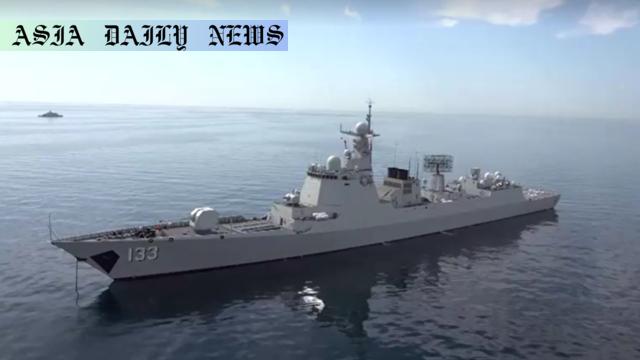Naval Drills: China, Russia, and Iran enhance strategic cooperation with extensive military exercises near the Gulf of Oman.
China, Russia, and Iran launch joint naval drills near the Gulf of Oman.
The drills feature over 10 Iranian ships, a Chinese destroyer, and Russian corvettes.
Observers from South Africa, Pakistan, and Oman are participating.
The exercises focus on maritime strikes, anti-piracy, and search and rescue operations.
These drills aim to enhance trust and cooperation among military forces.

Introduction: A Unified Naval Collaboration
The changing dynamics of global politics have brought China, Russia, and Iran closer as they conduct their annual joint naval drills. The exercise, which commenced near the Gulf of Oman, aims to strengthen not only their military coordination but also their shared strategic partnerships. With over 10 vessels from Iran, a major guided-missile destroyer from China, and corvettes from Russia, this demonstration of naval prowess invites both curiosity and cautious observation from the rest of the world. Observers from nations such as South Africa, Pakistan, and Oman have also joined to oversee the maneuvers, highlighting the wider geopolitical ramifications of such cooperation.
Key Components and Objectives of the Drills
Focusing on strikes against maritime targets, anti-piracy measures, and search-and-rescue operations, the drills encompass both fundamental and complex military strategies. The Chinese navy has expressed that these exercises aim to deepen mutual trust among participating forces and foster operational coordination. With an evolving global landscape, these joint operations underscore the significance of a multipolar world order where multiple nations pursue shared defense strategies as counterweights to traditionally dominant powers, including the United States.
Regional and Global Strategic Implications
Located near the geostrategically vital Gulf of Oman, these exercises send a strong message to the international community about shifting alliances and the increasing need for collective military readiness. For years, relations between the three nations and the United States have been adversarial. However, the intensification of such drills serves as both a symbolic and practical initiative to counter perceived Western hegemony. It also provides a platform for naval forces to test and refine their operational capabilities in a securely coordinated environment.
Observers and Broader International Participation
The presence of observers from nations such as South Africa, Pakistan, and Oman highlights the broader interest and potential alignment these countries may consider in the future toward such cooperative military initiatives. This aspect extends the scope of the drill beyond the participating nations and could indicate a growing resonance among nations that share skepticism about a unilateral global order. These exercises could form the basis of an increasingly cohesive and formidable coalition aimed at safeguarding shared interests.
Conclusion: A Ripple Effect in Global Geopolitics
As the drills conclude, the statement they make is clear: China, Russia, and Iran are united not just militarily but politically in the face of evolving global norms. While the focus remains on fostering mutual trust and enhancing operational effectiveness, the wider implications of these exercises cannot be ignored. With fresh collaborations, these countries could set the tone for a new wave in global power dynamics, showcasing their readiness to safeguard their shared goals strategically and militarily.
Commentary
The Significance of Multilateral Defense Drills
The annual naval drills involving China, Russia, and Iran present a unique statement of strategic intent in a world witnessing rapid shifts in alliances and geopolitical priorities. These exercises, set against the backdrop of ever-increasing global tensions, emphasize the shared priorities of these nations in maintaining regional stability and countering perceived threats to their collective sovereignty and influence. Such activities do not occur in isolation; they are a response to broader global movements and policies that these countries view as challenging their aspirations. The drills, therefore, function as both preparation and message: preparation for real-world contingencies, and a message to allies, rivals, and neutral states alike.
Geostrategic Messaging and Implications
What stands out is the location of the exercises—the Gulf of Oman. Known for its strategic importance due to its proximity to vital shipping lanes and its symbolic value in the energy trade, the region’s centrality in global geopolitics cannot be overstated. By conducting joint exercises here, these nations make a statement that they are capable actors in ensuring security in one of the most critical waterways. This is particularly resonant for nations skeptical about the singular dominance of Western military alliances, such as NATO, and reflects a growing sentiment toward multipolar power structures.
Toward a Multipolar Future
The inclusion of observers and potential participants like South Africa, Pakistan, and Oman further indicates that these drills are not just military exercises but part of a broader geopolitical agenda. As nations reassess their alliances and priorities, drills such as these could serve as the nucleus of a broader coalition to counterbalance dominant global forces. With their insistence on creating frameworks of trust among their navies, China, Russia, and Iran set a precedent for what cooperation in an unpredictable global order might look like. As these annual practices continue, they serve as an evolving narrative in the story of shifting global dynamics.


